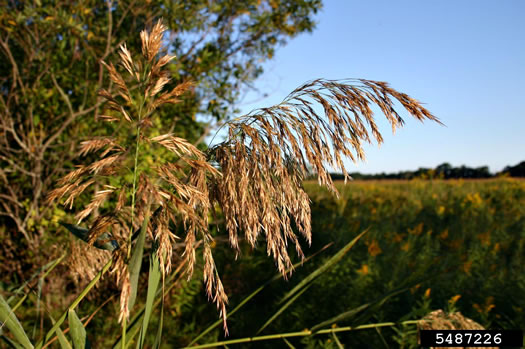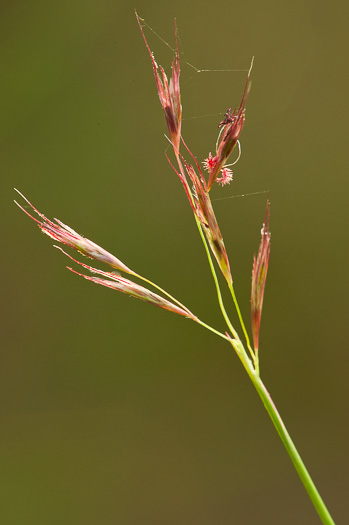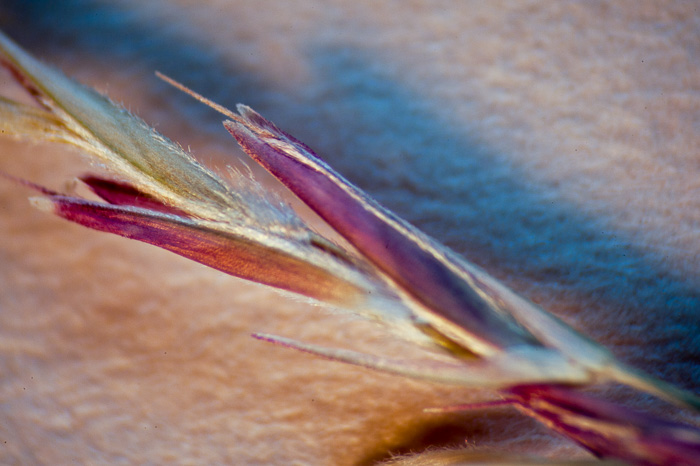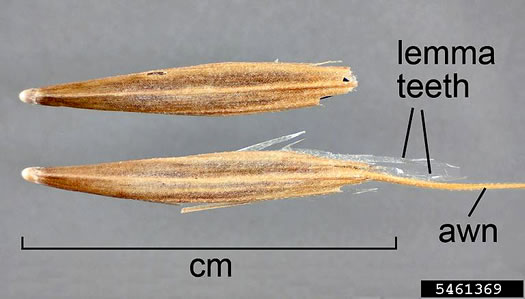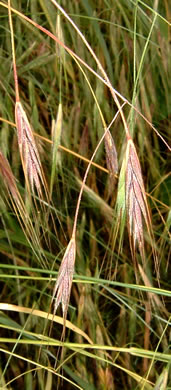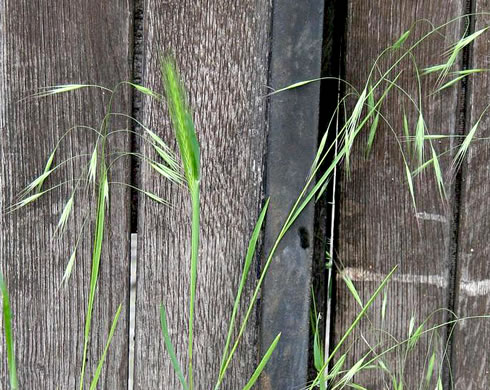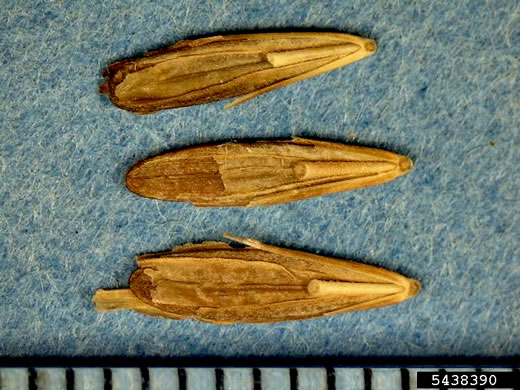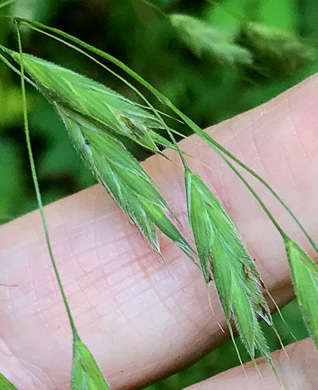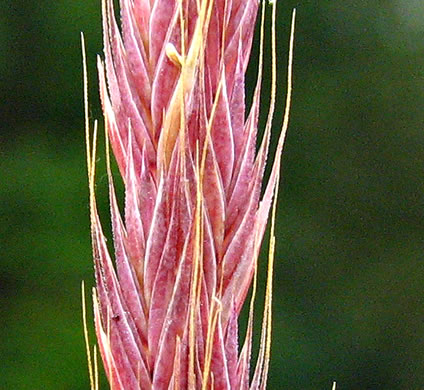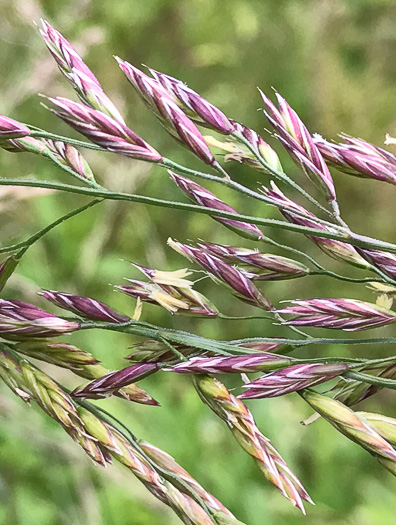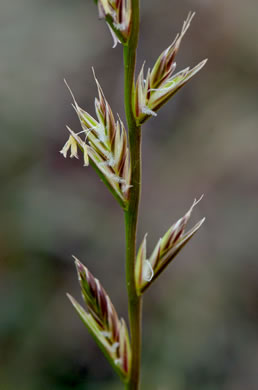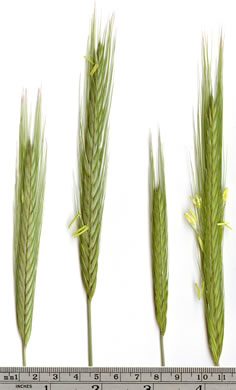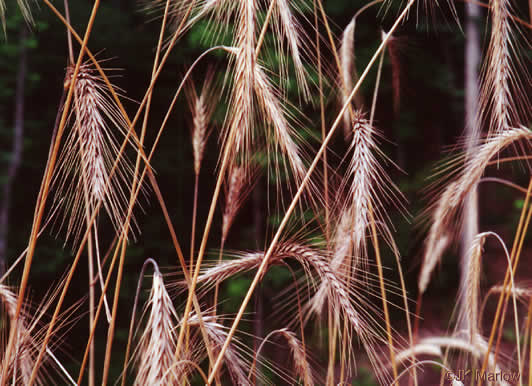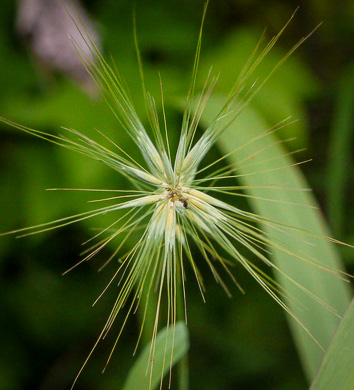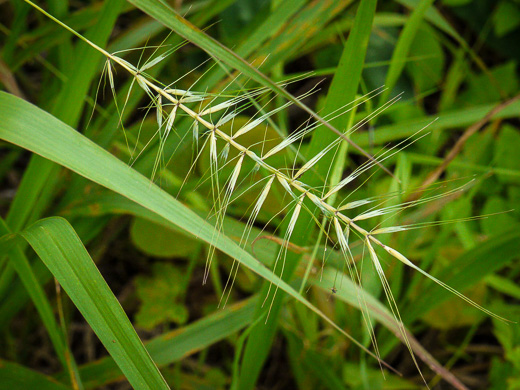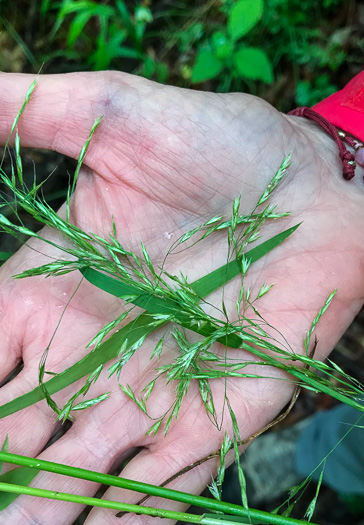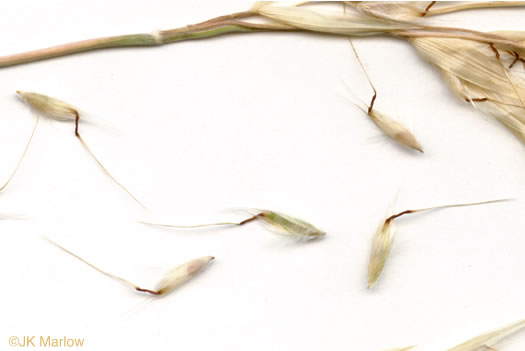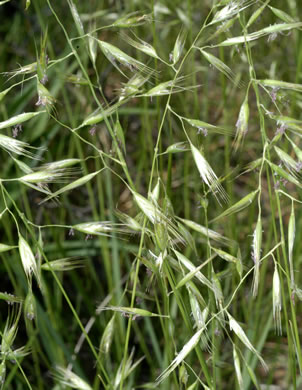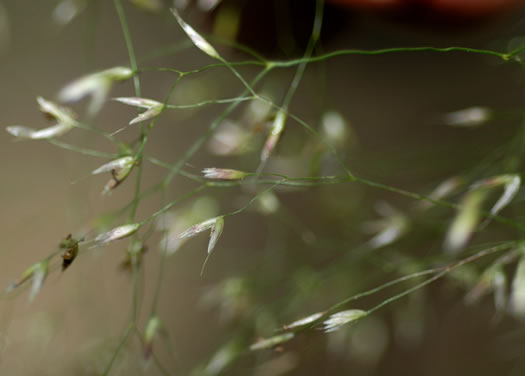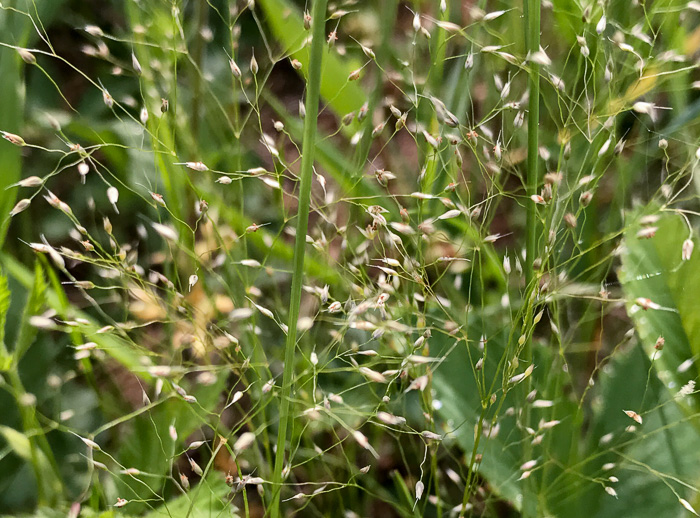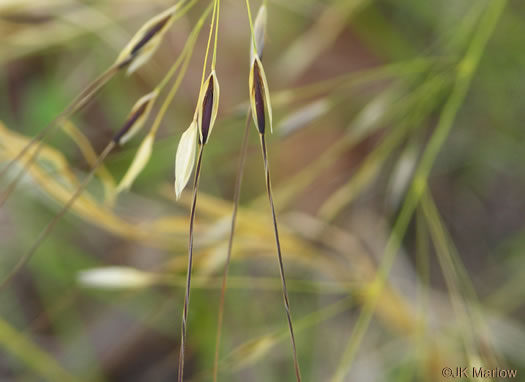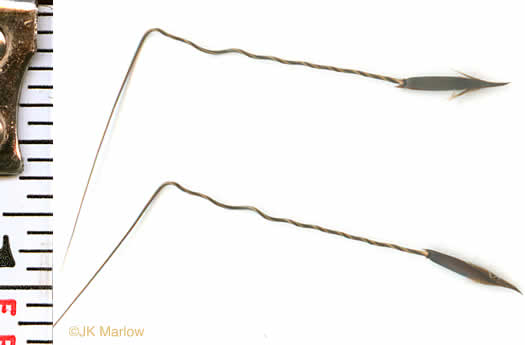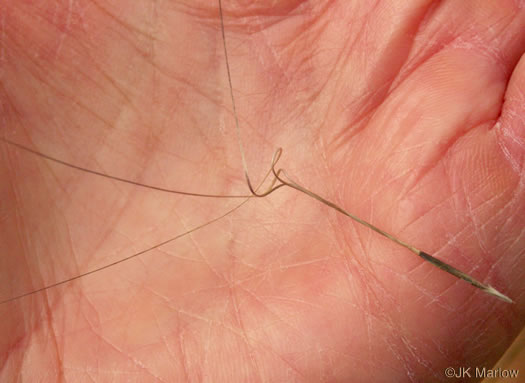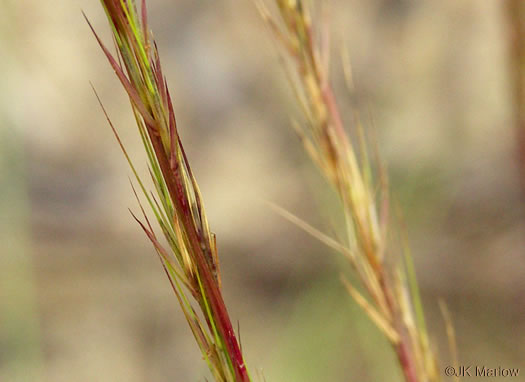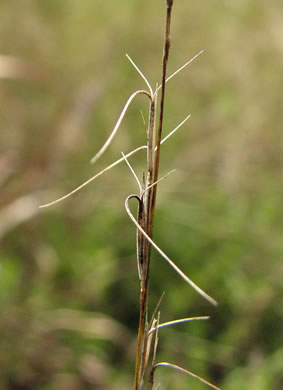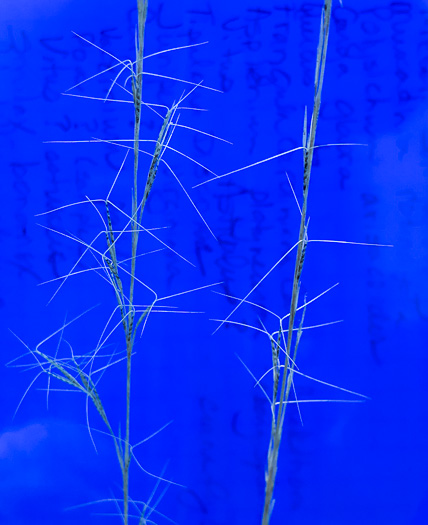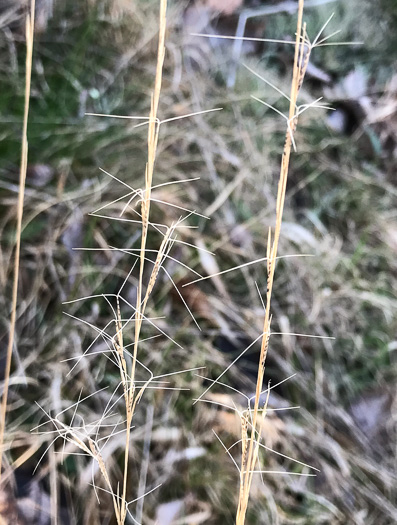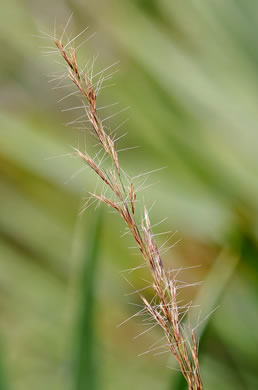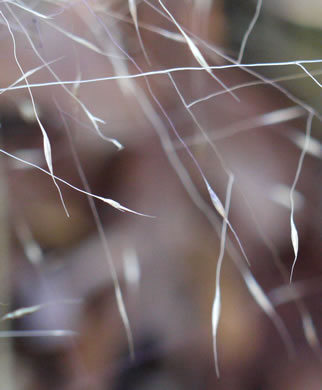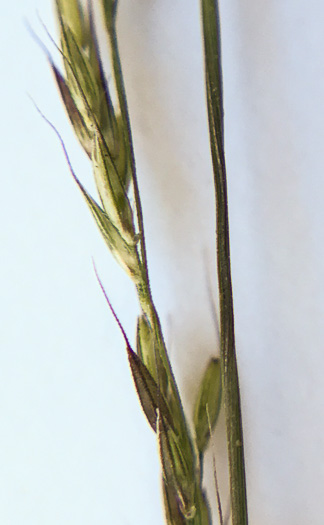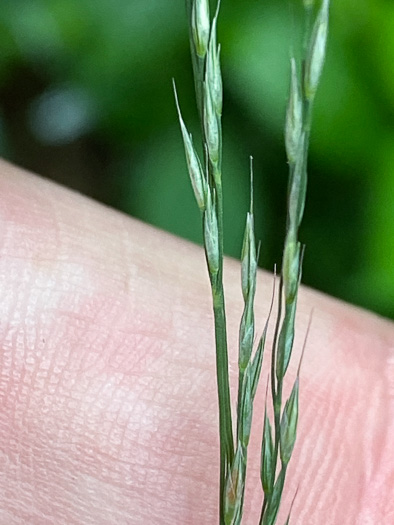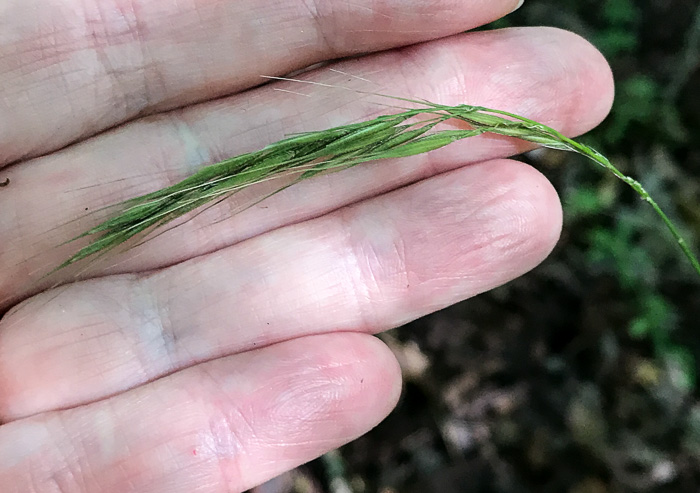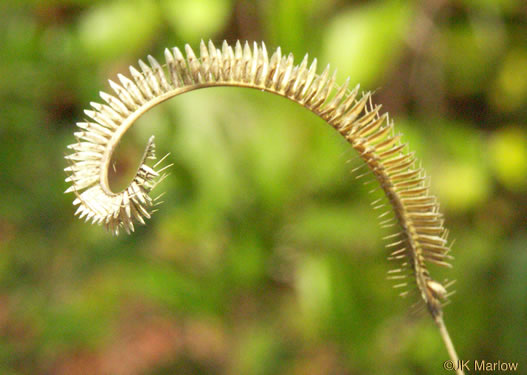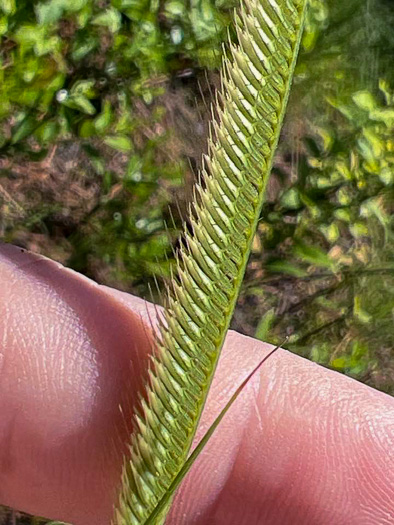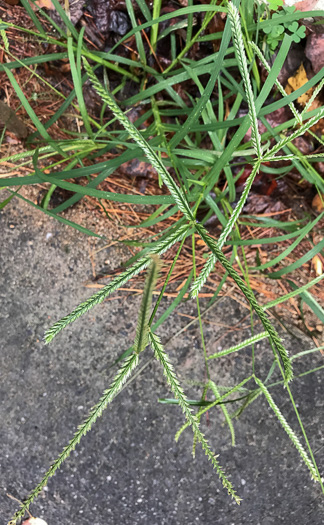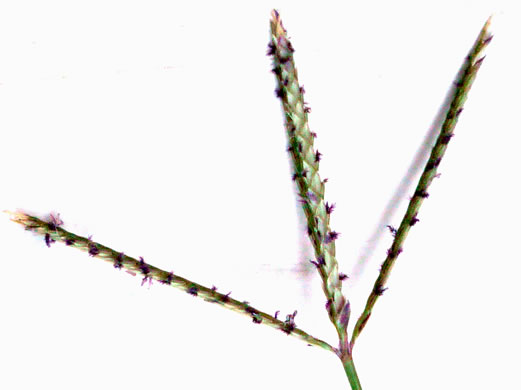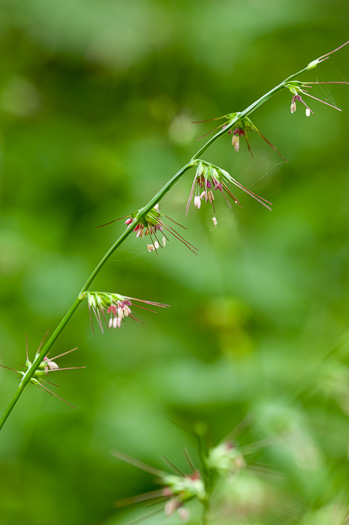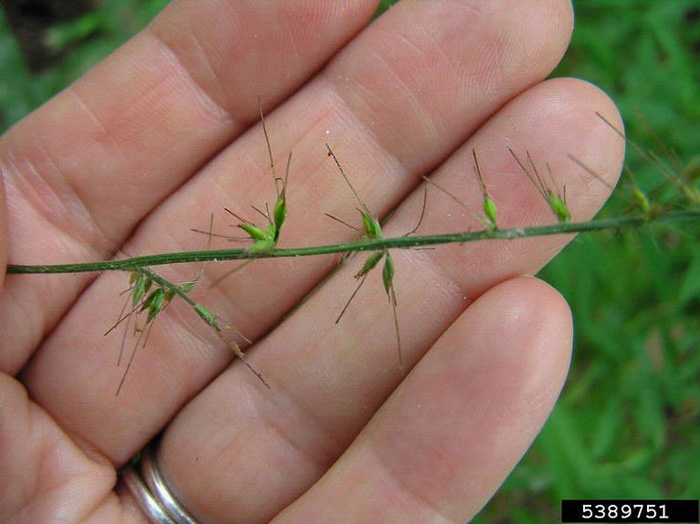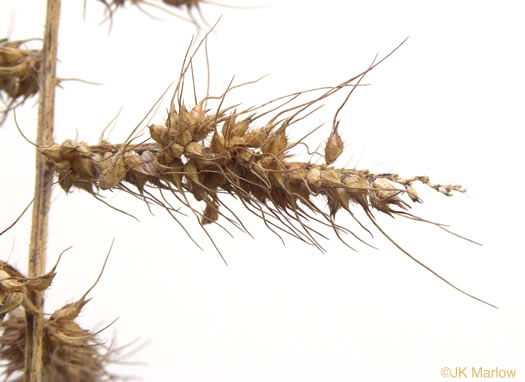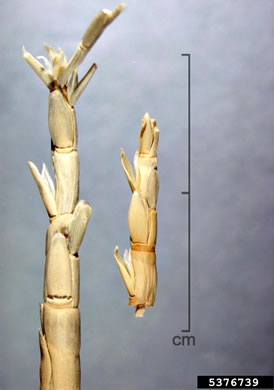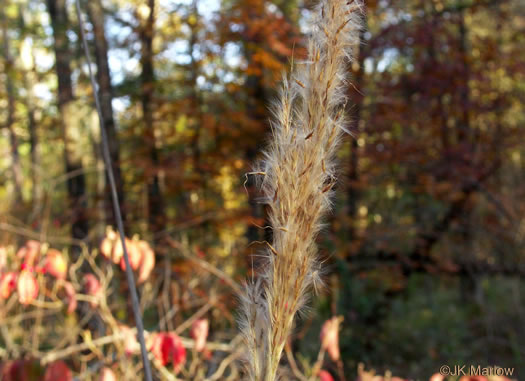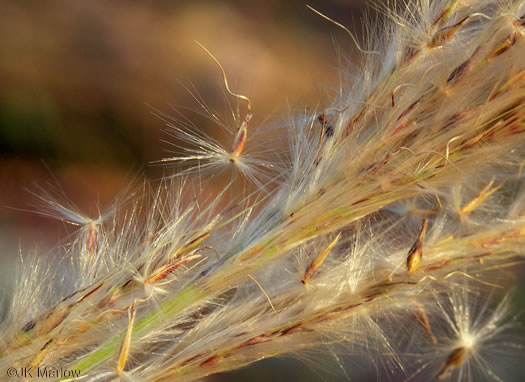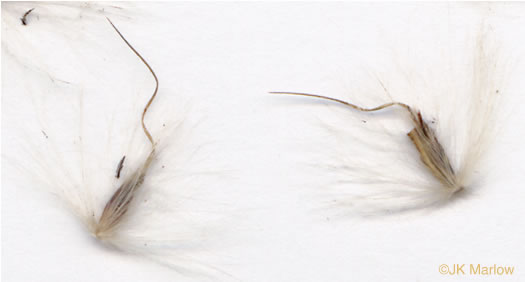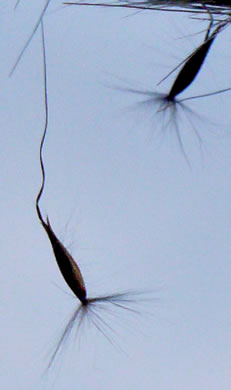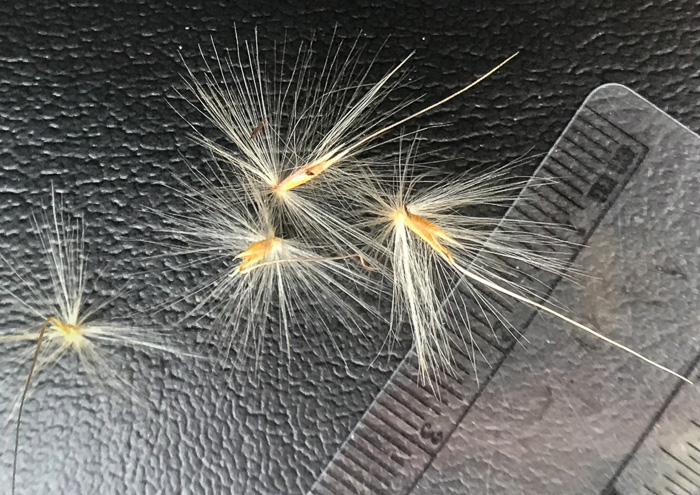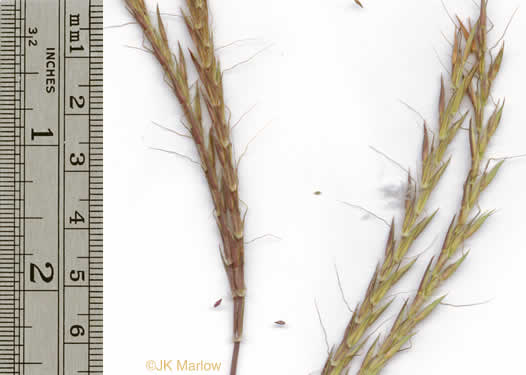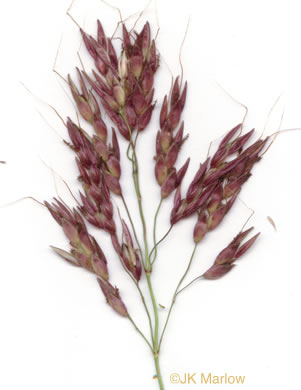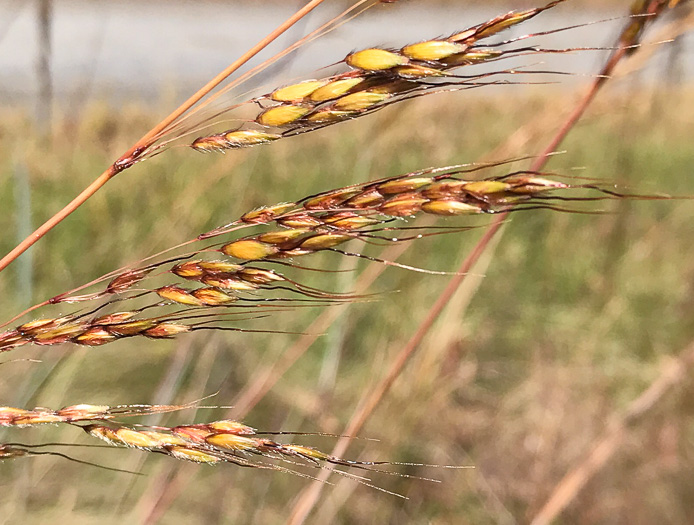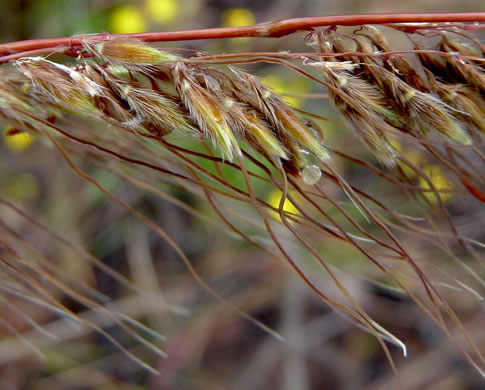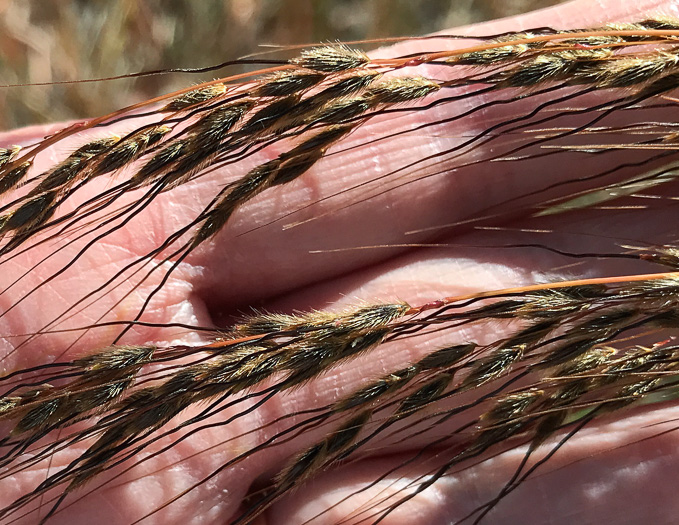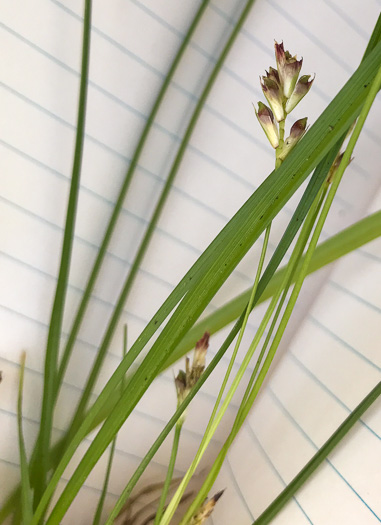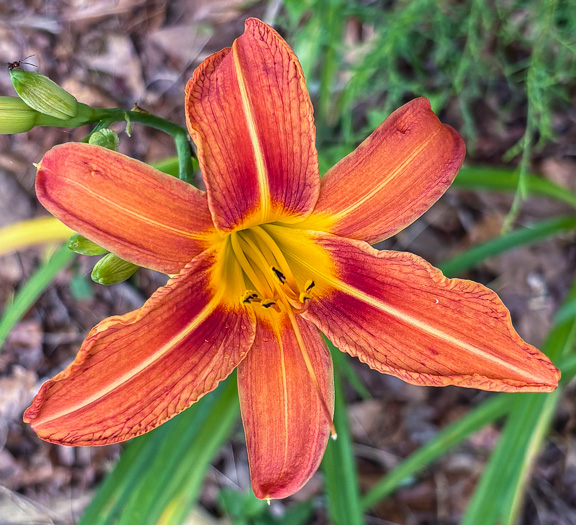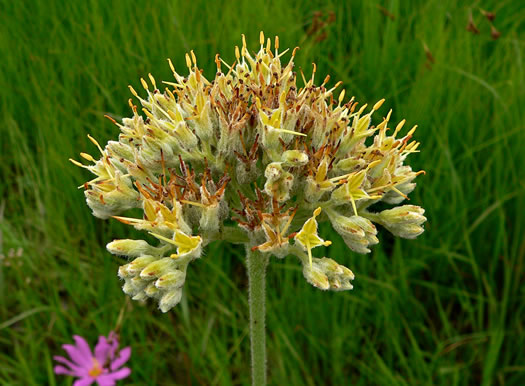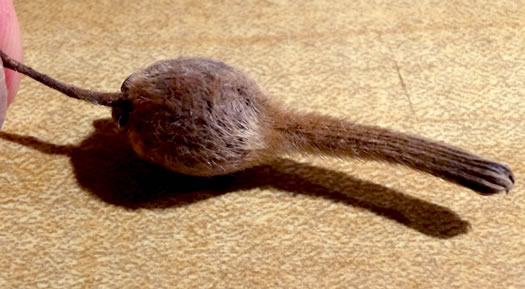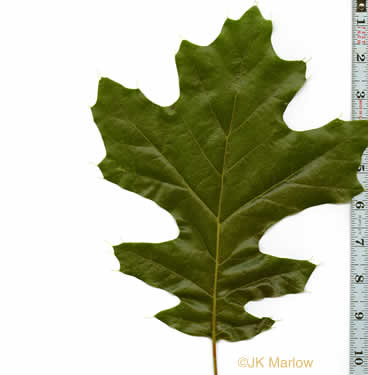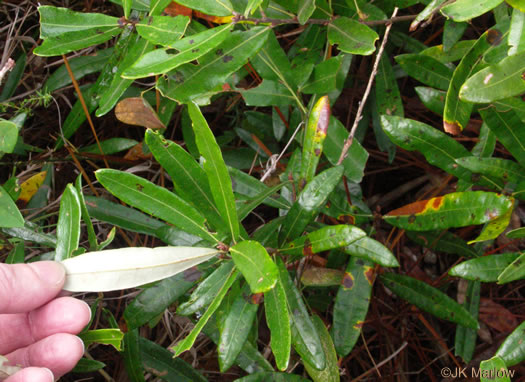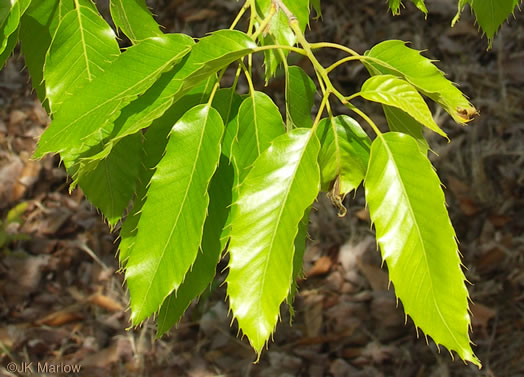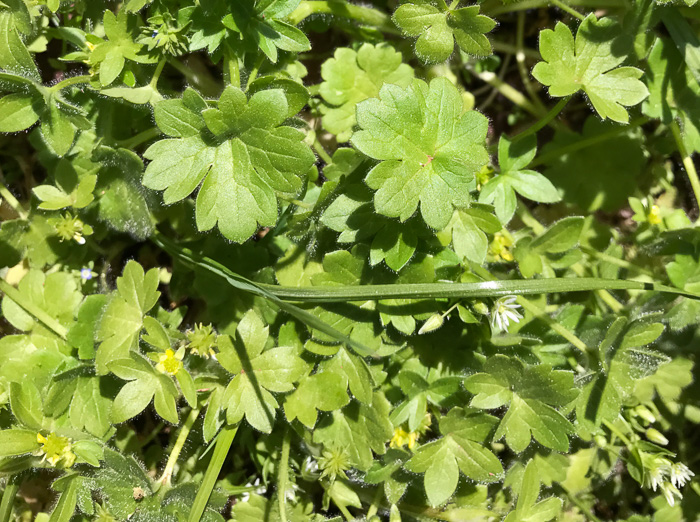Your search found 86 image(s) illustrating the term "awn." For a written explanation, click on "awn" in the Glossary.
PAGE 1 PAGE 2
To see larger pictures, click or hover over the thumbnails.
To go to the plant's detail page, click its name.
 Common Reed,
Phragmites australis
Common Reed,
Phragmites australis
Panicle tawny or purplish, 15-40cm long, the branches ascending, per Manual of the Grasses of the United States (Hitchcock & Chase, 1950).
 Southern Sandgrass,
Triplasis americana
Southern Sandgrass,
Triplasis americana
Spikelets usually purplish. Lemmas deeply cleft, awn more than 5mm long, per Vascular Flora of the Carolinas (Radford, Ahles, & Bell, 1968).
 Purple Sandgrass,
Triplasis purpurea var. purpurea
Purple Sandgrass,
Triplasis purpurea var. purpurea
Spikelets usually purplish. Lemmas cleft, awns straight, 0.5-1.5mm long, per Vascular Flora of the Carolinas (Radford, Ahles, & Bell, 1968).
 Downy Brome,
Bromus tectorum
Downy Brome,
Bromus tectorum
Lemmas narrowly lanceolate, toothed, with slender straight awns, per www.invasive.org.
 Poverty Brome,
Bromus sterilis
Poverty Brome,
Bromus sterilis
Spikelets 2.5-3.5cm long, 6-10 flowered; lemma awn 2-3cm long, per Manual of the Grasses of the United States (Hitchcock & Chase, 1950).
 Poverty Brome,
Bromus sterilis
Poverty Brome,
Bromus sterilis
Lemma awns 15-30mm, as long as or longer than lemma body, slender, straight, per Flora of North America.
 Smooth Brome,
Bromus inermis
Smooth Brome,
Bromus inermis
The bract enclosing the flower (the lemma) does not have a bristle (awn), per Invasive Plants, Guide to Identification, Impacts and Control (Kaufman & Kaufman, 2007).
 Hairy Woodland Brome,
Bromus pubescens
Hairy Woodland Brome,
Bromus pubescens
Lemmas 5-7 nerved, rounded, pubescent, 10-11mm long, awns 2.5-6mm long, per Vascular Flora of the Carolinas (Radford, Ahles, & Bell, 1968).
 Hairy Chess,
Bromus commutatus
Hairy Chess,
Bromus commutatus
Pedicels longer than the spikelets; lemma awns 5-12mm long, straight, per Weakley's Flora (2015).
 Southern Six-weeks Fescue,
Festuca octoflora var. octoflora
Southern Six-weeks Fescue,
Festuca octoflora var. octoflora
Lemma awns 0.3-6(9)mm long; spikelets w 5-11(-more) closely imbricate florets, per Weakley's Flora.
 Tall Fescue,
Lolium arundinaceum
Tall Fescue,
Lolium arundinaceum
Spikelets have 3-6 florets and lack awns. L. pratense is very similar, per Vascular Plants of North Carolina.
 Italian Ryegrass,
Lolium multiflorum
Italian Ryegrass,
Lolium multiflorum
At least upper lemmas awned (awns to 15mm long), per Weakley's Flora.
 Cereal Rye,
Secale cereale
Cereal Rye,
Secale cereale
Spike 6-15cm long including awns, 12-15mm broad, per Vascular Flora of the Carolinas (Radford, Ahles, & Bell, 1968).
 Cereal Rye,
Secale cereale
Cereal Rye,
Secale cereale
The lemmas have awns 2-6 cm long, per Weakley's Flora (2023).
 Common Bottlebrush Grass,
Elymus hystrix var. hystrix
Common Bottlebrush Grass,
Elymus hystrix var. hystrix
Lemmas convex, rigid, tapering into slender, straight awns 1-4cm long, per Manual of the Grasses of the United States (Hitchcock & Chase, 1950).
 Common Bottlebrush Grass,
Elymus hystrix var. hystrix
Common Bottlebrush Grass,
Elymus hystrix var. hystrix
Awned spikelets spread at right angles to rachis; glumes absent or reduced, per How to Know the Grasses: Pictured Key Nature Series (Pohl, 1954).
 Swamp Wedgescale,
Sphenopholis pensylvanica
Swamp Wedgescale,
Sphenopholis pensylvanica
The upper lemmas have a distinct awn 3-9mm long, per Vascular Plants of North Carolina.
 Silky Oatgrass,
Danthonia sericea
Silky Oatgrass,
Danthonia sericea
Lemma awn more than 10mm long, lemma body villous, per Vascular Flora of the Carolinas (Radford, Ahles, & Bell, 1968).
 Bog Oatgrass,
Danthonia epilis
Bog Oatgrass,
Danthonia epilis
Lemmas villous only on the margins and toward the base; awn twisted at base a single time, per Weakley's Flora (2023).
 Appalachian Hairgrass,
Avenella flexuosa
Appalachian Hairgrass,
Avenella flexuosa
Spikelets have 2 fertile flowers, each with a lemma with a striking bent awn, per Wildflowers & Plant Communities of the Southern Appalachian Mountains and Piedmont (Spira, 2011).
 Elegant Hairgrass,
Aira elegans
Elegant Hairgrass,
Aira elegans
Pedicels usually 2-8× long as spikelets; upper lemma awn 1.5-2.5mm, per Weakley's Flora (2020).
 Green Needlegrass,
Piptochaetium avenaceum
Green Needlegrass,
Piptochaetium avenaceum
Glumes 1.5cm long; lemma dark brown, 9-10mm long; awn 4.5-6cm long, per Manual of the Grasses of the United States (Hitchcock & Chase, 1950).
 Green Needlegrass,
Piptochaetium avenaceum
Green Needlegrass,
Piptochaetium avenaceum
Awns twisted, 4-6 cm long, per Vascular Flora of the Carolinas (Radford, Ahles, & Bell, 1968).
 Seaside Three-awn,
Aristida tuberculosa
Seaside Three-awn,
Aristida tuberculosa
Awns 30-40mm long, not including "column" of connivent awns twisted together, per Weakley's Flora.
 Carolina Wiregrass,
Aristida stricta
Carolina Wiregrass,
Aristida stricta
Awns divergent, the central 1-1.5cm long, the lateral a little shorter, per Manual of the Grasses of the United States (Hitchcock & Chase, 1950).
 Southern Wiregrass,
Aristida beyrichiana
Southern Wiregrass,
Aristida beyrichiana
Awns divergent, the central 1-1.5cm long, the lateral a little shorter, per Manual of the Grasses of the United States (Hitchcock & Chase, 1950).
 Southeastern Slimspike Three-awn,
Aristida longespica
Southeastern Slimspike Three-awn,
Aristida longespica
Central awn sharply curved at base, spreading; lateral awns erect, shorter, per Manual of the Grasses of the United States (Hitchcock & Chase, 1950).
 Arrowfeather,
Aristida purpurascens
Arrowfeather,
Aristida purpurascens
Awns divergent, 10-25mm long, central awn ascending, per Vascular Flora of the Carolinas (Radford, Ahles, & Bell, 1968).
 Arrowfeather,
Aristida purpurascens
Arrowfeather,
Aristida purpurascens
Spikelets with 3 straight to spreading awns, 12-25mm long, per Forest Plants of the Southeast and Their Wildlife Uses (Miller & Miller, 2005).
 Big Three-awn,
Aristida condensata
Big Three-awn,
Aristida condensata
Awns equal, divergent, 10-15mm long, the base more or less contorted, per Manual of the Grasses of the United States (Hitchcock & Chase, 1950).
 Pink Muhlygrass,
Muhlenbergia capillaris
Pink Muhlygrass,
Muhlenbergia capillaris
Spikelets one-flowered, awns 3-12mm long, per Vascular Flora of the Carolinas (Radford, Ahles, & Bell, 1968).
 Nimblewill,
Muhlenbergia schreberi
Nimblewill,
Muhlenbergia schreberi
Ear [inflorescence] 5" long; earlet [spikelet] sharp pointed with 1 long awn, per Field Guide to the Grasses, Sedges & Rushes of the US (Knobel, 1899) (Faust, 1977).
 Slender Muhly,
Muhlenbergia tenuiflora
Slender Muhly,
Muhlenbergia tenuiflora
Glumes relatively broad, abruptly narrowed to acuminate tip; lemma awn 1-11mm (rarely awnless), per Weakley's Flora (2023).
 Bearded Shorthusk,
Brachyelytrum erectum
Bearded Shorthusk,
Brachyelytrum erectum
Inflorescence ~ 4-7" long, spikelets strongly ascending with very long awns, per Vascular Plants of North Carolina.
 Toothache Grass,
Ctenium aromaticum
Toothache Grass,
Ctenium aromaticum
A recurved 1-sided spike bearing spikelets in 2 rows, with conspicuous awns, per Atlantic Coastal Plain Wildflowers (Nelson, 2006).
 Toothache Grass,
Ctenium aromaticum
Toothache Grass,
Ctenium aromaticum
Flowers on only one side of the spike, each with awns, looking comblike, per Wildflowers of the Sandhills Region (Sorrie, 2011).
 Goosegrass,
Eleusine indica
Goosegrass,
Eleusine indica
Spikelets in 2 rows on one side of spikes, lemmas and glumes awnless, per Wildflowers of the Eastern United States (Duncan & Duncan, 1999).
 Bermuda Grass,
Cynodon dactylon
Bermuda Grass,
Cynodon dactylon
Spikelets 1-flowered, awnless, sessile in 2 rows along one side of rachis, per Manual of the Grasses of the United States (Hitchcock & Chase, 1950).
 Shortleaf Basketgrass,
Oplismenus setarius
Shortleaf Basketgrass,
Oplismenus setarius
Racemes subglobose, each w about 5 spikelets; awn of first glume 4-8mm long, per Manual of the Grasses of the United States (Hitchcock & Chase, 1950).
 Wavyleaf Basketgrass,
Oplismenus undulatifolius
Wavyleaf Basketgrass,
Oplismenus undulatifolius
Florets pinkish w long sticky awns that readily adhere to animals & people, per New Invaders of the Southeast (Rawlins et al., 2018).
 Rough Barnyard-grass,
Echinochloa muricata var. muricata
Rough Barnyard-grass,
Echinochloa muricata var. muricata
Spikelets > 3.5mm long. Sterile lemma usually awned, the awn 6-25mm long, per Weakley's Flora.
 Itch-grass,
Rottboellia cochinchinensis
Itch-grass,
Rottboellia cochinchinensis
Spikelets awnless, in pairs at the nodes of a thickened articulate rachis, per Manual of the Grasses of the United States (Hitchcock & Chase, 1950).
 Silver Plumegrass,
Erianthus alopecuroides
Silver Plumegrass,
Erianthus alopecuroides
Inflorescence of many racemes in a dense, silvery to tawny, plume, per Wildflowers of Tennessee, the Ohio Valley, and the Southern Appalachians (Horn, Cathcart, Hemmerly, & Duhl, 2005).
 Silver Plumegrass,
Erianthus alopecuroides
Silver Plumegrass,
Erianthus alopecuroides
Awn twisted, bristle hairs from spikelet base longer than spikelet, per Forest Plants of the Southeast and Their Wildlife Uses (Miller & Miller, 2005).
 Silver Plumegrass,
Erianthus alopecuroides
Silver Plumegrass,
Erianthus alopecuroides
Callus beard exceeds spikelet. Awn spirally twisted, flattened basally, per Vascular Flora of the Carolinas (Radford, Ahles, & Bell, 1968).
 Bent-awn Plumegrass,
Erianthus contortus
Bent-awn Plumegrass,
Erianthus contortus
Awn spirally twisted, flattened basally, per Vascular Flora of the Carolinas (Radford, Ahles, & Bell, 1968).
 Sugarcane Plumegrass,
Erianthus giganteus
Sugarcane Plumegrass,
Erianthus giganteus
Callus beard exceeds spikelet. Awn nearly straight, terete, scaberulous, per Vascular Flora of the Carolinas (Radford, Ahles, & Bell, 1968).
 Big Bluestem,
Andropogon gerardi
Big Bluestem,
Andropogon gerardi
Bristles (awns) that project from the flowers are sharply bent, per Book of Field and Roadside (Eastman, 2003).
 Johnsongrass,
Sorghum halepense
Johnsongrass,
Sorghum halepense
Spikelets paired: one silky and sessile, one stalked and smooth, both w awns, per Wildflowers of Tennessee (Carman, 2005).
 Yellow Indiangrass,
Sorghastrum nutans
Yellow Indiangrass,
Sorghastrum nutans
Spikelets 6-8 mm long, lanceolate, hirsute, the awns 10-15 mm long, per Manual of the Grasses of the United States (Hitchcock & Chase, 1950).
 Lopsided Indiangrass,
Sorghastrum secundum
Lopsided Indiangrass,
Sorghastrum secundum
Awn 20-35mm long, twice-geniculate, twisted below second the bend, per Manual of the Grasses of the United States (Hitchcock & Chase, 1950).
 Elliot's Indiangrass,
Sorghastrum elliottii
Elliot's Indiangrass,
Sorghastrum elliottii
Spikelets 6-7mm long, the awns 25-35mm long, per Manual of the Grasses of the United States (Hitchcock & Chase, 1950).
 Longstalk Sedge,
Carex pedunculata
Longstalk Sedge,
Carex pedunculata
Midrib of pistillate scales extending to an awn that may greatly exceed the tip of the perigynia, per www.minnesotawildflowers.info.
 Orange Daylily,
Hemerocallis fulva
Orange Daylily,
Hemerocallis fulva
Flowers tawny-orange (or variants), not fragrant; inner tepal margins wavy, per Weakley's Flora (2018).
 Carolina Redroot,
Lachnanthes caroliniana
Carolina Redroot,
Lachnanthes caroliniana
Stems distally whitish villous-tomentose when young, becoming tawny-hoary, per Flora of North America.
 Beaked Hazelnut,
Corylus cornuta var. cornuta
Beaked Hazelnut,
Corylus cornuta var. cornuta
Fruit husk drawn out into an elongate beak and covered by short stiff hairs, per Woody Plants of the Southeastern US: A Winter Guide (Lance, 2004).
 Black Oak,
Quercus velutina
Black Oak,
Quercus velutina
Leaf blades leathery, upper surfaces shiny, lower w tawny hairs along veins, per Native Trees of the Southeast, An Identification Guide (Kirkman, Brown, & Leopold, 2007).
 Running Oak,
Quercus elliottii
Running Oak,
Quercus elliottii
Leaves usually unlobed, awned at tip, grayish and pubescent on undersurface, per Woody Plants of the Southeastern US: A Winter Guide (Lance, 2004).
 Sawtooth Oak,
Quercus acutissima
Sawtooth Oak,
Quercus acutissima
Leaves resemble those of Castanea, with awn-terminated marginal teeth, per Woody Plants of the Southeastern US: A Winter Guide (Lance, 2004).
 Small-flowered Buttercup,
Ranunculus parviflorus
Small-flowered Buttercup,
Ranunculus parviflorus
A weed in lawns and waste areas, soft-hairy, with flowers only 1/8" across, per Wildflowers of the Southern Mountains (Smith, 1998).

